Features of kitchen aprons from tiles
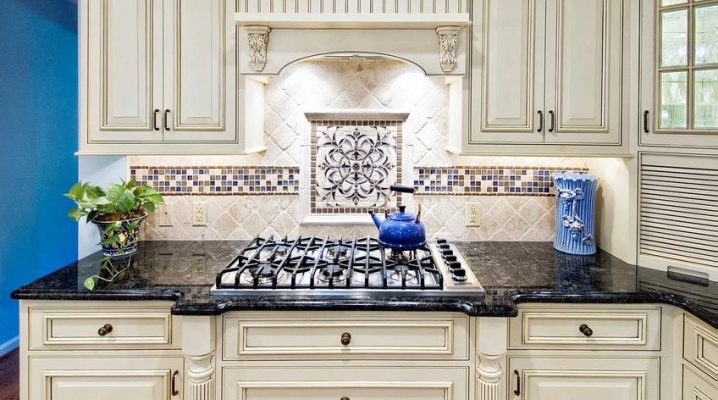
Tile is a popular material in the lining of kitchen aprons. It is chosen for a number of quality characteristics. From the material of this article, you will learn what the pros and cons of tiled aprons are, what types of material are, and what are the subtleties of styling.

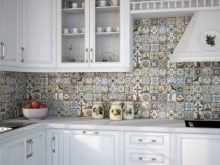

Advantages and disadvantages
A tile apron has a number of advantages.
- It is distinguished by its aesthetic appeal and is often a decoration of the kitchen interior, bringing its status to the design.
- Tiles are able to emphasize any stylistic design solution - from laconic minimalism to luxurious oriental stylistics and their inherent variegated design.
- Tiles are sold in the widest range, and therefore the buyer can choose even the most unusual option if it suits the interior design and fits into the budget.
- The texture of this material can be very diverse. In addition to the usual gloss and dullness, it is able to convey a lot of different illusions, whereby you can give the surface the look of any building material.
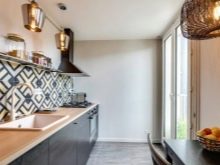
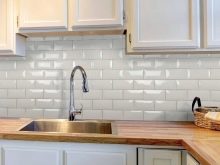
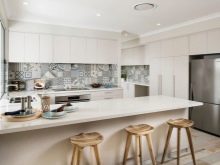
- The tiled apron is characterized by practicality and durability. The material is resistant to moisture, fungus, temperature changes and abrasives. The tile does not fade during the operation of the apron, and therefore its appearance will always be fresh.
- Laying the apron can be very diverse, from simple with crosshairs to rhombuses, honeycombs, panels.
- The pricing side of the issue is built with an approach to each customer, such an apron, along with related materials and tools, will fit into the planned budget.
- An ordinary owner of the family will be able to perform some types of styling. To do this, you must clearly follow the instructions of professionals.
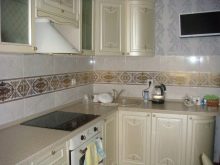
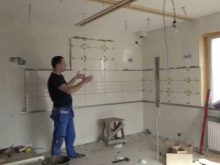
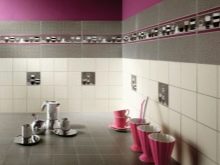
In addition to the advantages, tiled aprons for the kitchen also have disadvantages. One of them is the seams - "sore spots" of the laying. In addition to the fact that they need special attention when filling the joints, the grout becomes dirty quickly under the influence of grease. If the tile itself is easy to scrub, then the seams will eventually lose their aesthetic appeal.
Dismantling such an apron is problematic, you will have to remove the material along with the cement, and this is a lot of dirt and construction dust. Another nuance is the difficulty of cutting tiles, which cannot be avoided regardless of the size of the material.
Circles are especially difficult to cut. The trimming will have to be adjusted in such a way that symmetry is respected.

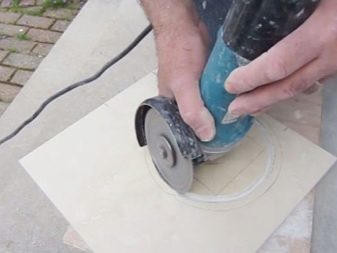
Types of materials
Different types of raw materials are used for laying a kitchen backsplash from tiles. Let's consider the main nuances of the most demanded material.
Ceramic
Ceramics is one of the most popular finishing materials. It is characterized by low weight, tolerates high humidity. It is made from a charge mass that includes kaolin, sand, quartz, mica and mineral oxides. The material stands out for its durability, hygiene, fire safety, and affordability.
The disadvantages are the need for calibration, high thermal conductivity, slipperiness, and sound transmission.
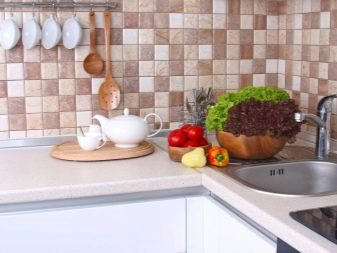

Glass
This tile differs from ceramics not only in appearance, but also in composition. It is practical, not capricious in care, does not absorb odors and dirt. The material is resistant to moisture, is able to visually expand the space and retains its aesthetic appeal for a long time.Glass tiles are used in the interior to give it a touch of luxury and high status.
The disadvantage of raw materials is fragility: such a tile is unstable to mechanical damage and needs special delicacy during the facing work.
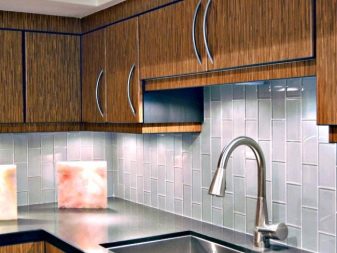
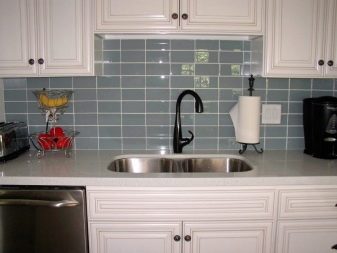
Mirrored
Such material is distinguished by the ability to increase not only the space, but also the level of its illumination. It is distinguished by ease of installation, moisture resistance, a wide range, and a high level of resistance to mechanical stress. This tile is made in different designs and colors. The disadvantage of such a cladding is the dark spots that appear during operation.
In addition, the material may chip or scratch if hit hard. Another nuance is the high cost.
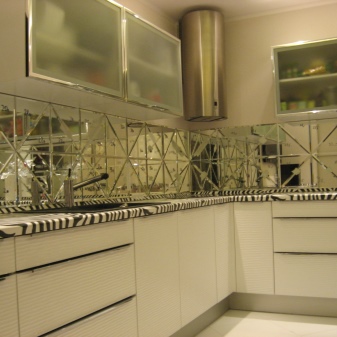
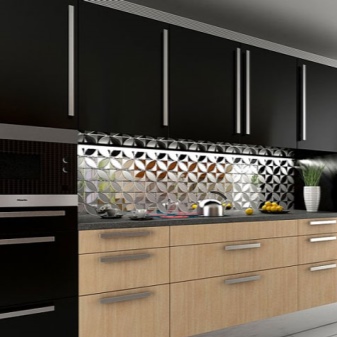
Pvc
This material appeared on the market of finishing raw materials not so long ago, but has already been highly appreciated by buyers. This is a budget type of tile that is easy to clean and has no joints. This apron is easy to install. However, this is where all the advantages end: PVC tiles are afraid of a rise in temperature, they are not entirely environmentally friendly.
Despite the visual appeal and a lot of different colors, such an apron is short-lived.

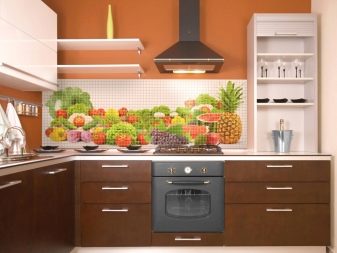
Dimensions (edit)
The sizes of backsplash tiles may vary. They are selected taking into account the dimensions of the room itself, correlating with the minimization of the amount of cutting. Based on the dimensions, the calculation is performed, using online calculators for convenience, which make it possible to make the most rational layout, taking into account the standard height and width of the apron.
This is convenient and simplifies independent calculations, although in the case of a complex apron configuration (the presence of protrusions or niches, laying to the ceiling), they are not always suitable.


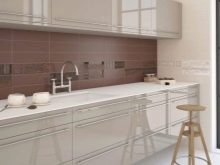
The standard dimensions of the backsplash tile are 10x10 cm. This modular format reduces the amount of trimming during veneering. Such tiles visually increase the parameters of the useful area of the kitchen. In addition to it, on sale you can buy square-shaped dies with an edge size of 15, 20 and 30 cm.
In addition to them, you can glue the working wall with tiles 20x25, 20x30 and 30x40 cm. The dimensions of the hog tiles are 65x120, 75x150, 85x285, 100x200, 100x250, 150x450 mm. The parameters of the demanded mosaic have a square edge ranging from 2 to 5 cm.


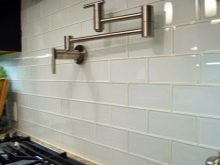
Color solutions
Today, the choice of a shade for an apron depends on the tone of the furniture or any interior accessories. Given that there is little natural light in the kitchen, light colors are more often used in design. These are white, beige, blue, lilac, peach tones. They make up for the lack of light, thereby visually increasing the size of the kitchen space.
You can combine light shades with bright or even dark ones. Of the dark contrasts, purple, wine and woody colors are relevant today. Bright colors that can bring a positive mood to the atmosphere are red, orange, turquoise and green. In this case, a strong red paint must be dosed, avoiding that it takes the role of a dominant.

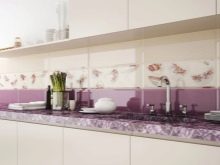
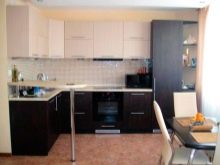
As for shades of green, they are very popular today. They can be used in the form of individual elements, borders, stripes, any part of the picture. Black tiles are good for light interiors, although their amount needs to be dosed more than other shades. Despite its practicality, it is capable of introducing a negative perception of space.
To avoid visual imbalance, you can buy it in a set with white, choosing companion modules.

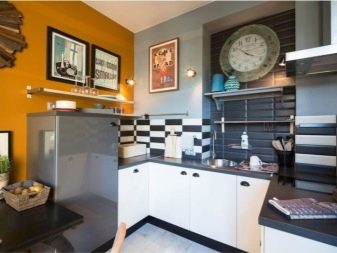
Design options
You can lay out the tiles in different ways, which will be facilitated by the design ideas and features of the existing furniture, as well as its location and the nuances of the working wall. The backsplash fabric can be a strip of different widths. Depending on the specific headset, the design may vary. For example, it can be herringbone, honeycomb, mosaic cladding.
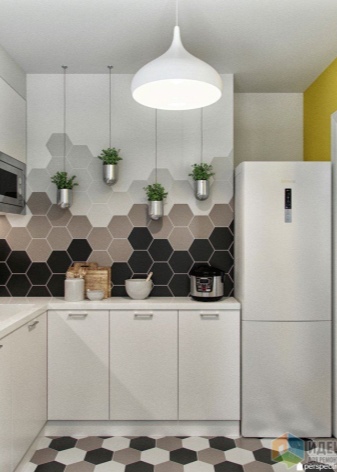
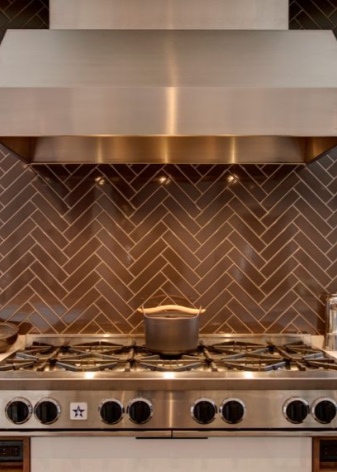
In addition, the design of the apron itself may differ. It can be monochromatic, variegated, in the form of a slab with an ornamental strip extending along its entire length from one edge or in the center. In some cases, a technique with a checkerboard arrangement of accent plates is used. Sometimes the border becomes the decoration of the apron. The reception of panels is considered a beautiful and modern type of design. Also, a popular design solution is the contrast of the texture of the backsplash tile and accentuation of another area of the kitchen (for example, a combination of matte for the backsplash and glossy for the floor).
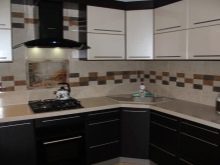
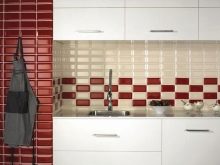

Both smooth and embossed tiles can be used in decoration. However, the ease of care must be assessed. As for the drawings on the dies, their relevance is determined by the stylistic solution of the interior. Someone prefers to decorate the kitchen with tiles with flowers, others like dishes, and still others like fruits.
Choosing this or that option, you need to understand that for harmony it is preferable to choose a print that will not merge with the furnishings. Therefore, the same monograms will look more organic in design than cups of tea or coffee beans. But if there are a minimum of trifles in the room, the dishes are removed in a wall cabinet, fruits or a cup of tea in the design of the apron has every chance of a harmonious infusion into the interior.
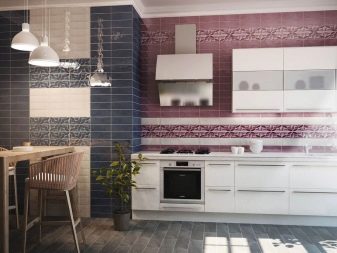
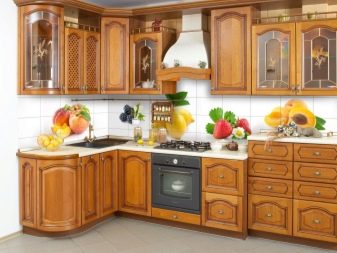
Consider several of the most relevant layouts for a tiled apron.
Classical
This method involves laying the usual type with the formation of crosshairs, this is a typical cladding method for beginners. For it, use square-shaped dies of the same size. The width of the joints is selected based on the size of the tile elements. Color solutions for such styling can be very diverse.
Classic styling can be combined with diamond styling. In addition, it looks good when it is the basis of an apron with a decorative panel. You can use this type of styling in any design style, be it Provence, country, Gzhel or loft, grunge, chalet, patchwork.
In each case, the bet should be made on the furniture used, choosing shades to match the tone of the facades or accessories.
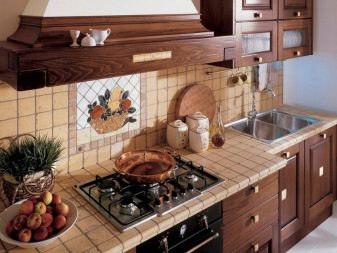
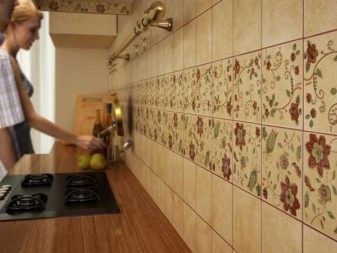
Mosaic
This apron allows you to diversify the design of the kitchen. In fact, a mosaic is a mass of the smallest elements, which are laid both in the traditional and compositional way. Some fragments have to be independently adjusted to the pattern, achieving the identity of the seams.
Others are arranged fragmentarily on the grid, and therefore such styling is initially simpler, it is similar to the classic on a reduced scale. The use of mosaic installation is preferable in designs with an emphasis on minimalism and dispensing small furnishings.
If there are too many small things in the interior, a mosaic apron will enhance the effect of clutter in the kitchen. His styles are minimalism, hi-tech, constructivism.

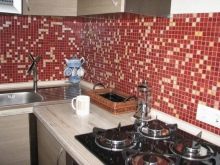
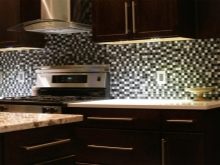
"Wild boar"
This installation is nothing more than an interpretation of brickwork. Basically, it uses a shift technique. Elements must be rectangular. They can be placed both traditionally horizontally and perpendicular to the floor. This styling method is relevant for such design directions as loft, chalet and grunge, as well as brutalism.
Facing upwards and with a shift according to the herringbone principle is used in other stylistic branches of interior design.
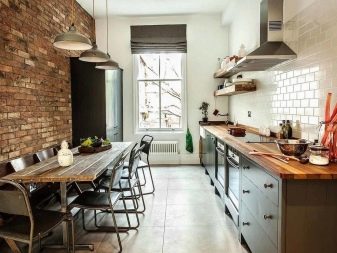
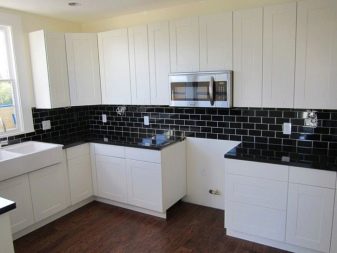
Honeycomb
Such a tile looks unusual, however, it cannot be called universal. It is not suitable for every interior due to its complex visual effect. In fact, these are hexagonal geometric dies, which are glued one by one, observing the identity of the width of the seams. The work is quite difficult, only a professional tiler can perform it perfectly.
You can use such a design in modern stylistic directions with an emphasis on minimalism and strict functionality (for example, in the style of minimalism).

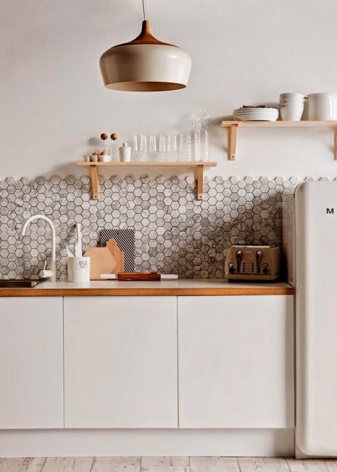
Panel
For the panel, different tiling schemes are chosen.It can be the layout of a complex picture from the smallest elements, enclosed in a border frame. Also, laconic pictures are created under the panel, using ready-made images on the grid. The second materials are convenient in that you do not need to select the elements of the picture, laying them out before the main work on the floor for the visibility of the complete picture.
They use the panel technique more often in directions that seek to demonstrate the atmosphere of home comfort. At the same time, the area of the kitchen should be sufficient for the panel to look organic. For example, it can be country style, Provence. If you want to decorate a patchwork style with a similar decor with its characteristic craving for variegation, you will have to dose the size of the panel, choosing a small area of the kitchen apron for it.
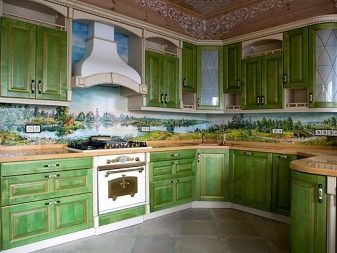
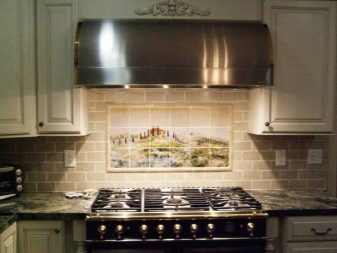
Under the tree
Such a kitchen finish is considered one of the most demanded today. As a rule, aprons of this type are made for light interiors. From a distance, such tiles resemble boards glued to the wall horizontally. Against the general background, a similar decor looks not only stylish, but also spectacular. The imitation of the wood texture is created with PVC tiles or a combination of ceramic tiles of different sizes.
The tile manufacturing technology allows you to recreate the authentic texture of any kind of wood, which favorably raises the status of the interior. Tiles with wood texture can be used in different directions of design, including ecological and ethnic branches of stylistics. It can be English, antique style, art deco, vintage.
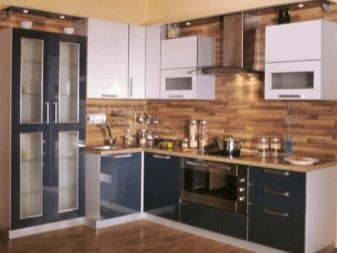
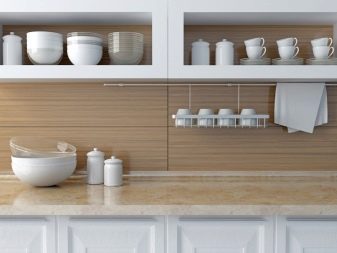
How to choose?
Choosing a tile for finishing a working wall is necessary based on a number of factors. They buy it from a trusted manufacturer with a good reputation, gaining a stock of 10-15% of the total (accounting for defects in work). You need to take modules from one batch: this eliminates the risk of buying dies of different shades and different thicknesses. They select a design that will suit the interior of a particular kitchen.
It is preferable to use plain modules with a discreet finish: by doing so, you will leave yourself the opportunity to include useful little things in the interior. You can decorate the panel with a small insert or bet on the uniqueness of the texture. So the coating will look expensive, and the interior will not be overloaded.
Light lace or brickwork look better in design than variegated colors surrounded by a large number of furniture elements.
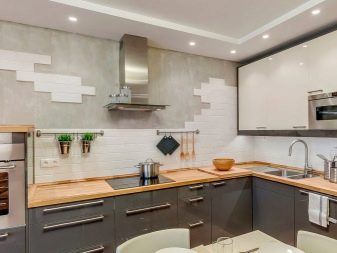
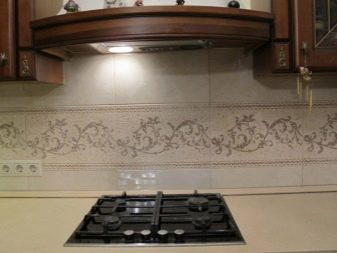
Patchwork needs to be selected for the kitchen with a minimum of furnishing details. At the same time, small modules in soft colors will look more harmonious. The number of contrasting shades of patterns should not exceed four. For ethnic and Scandinavian patterns, sometimes two are enough. The drawing should not complicate the perception of the kitchen, the eyes should not get tired when looking at it.
To match the tone, which is difficult to achieve due to the artificial illumination of the dies in the showcase, you can take from the house any small object of the desired color that matches the tone of the furniture facade or its finish. It is preferable to choose a grout in a related range of tiles. If the tile is colored, you shouldn't buy a white grout for it: it is impractical.

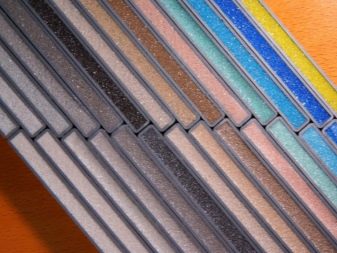
You need to inspect each module when buying: this will eliminate the risk of buying a marriage with chips or irregularities. If possible, you need to inspect the geometry: if the corners are visually curved, it will not be possible to perform high-quality cladding.
You should not take the leftovers, thinking that in the future you will be able to pick up a beautiful companion for them. This rarely happens, and even in the remains, tiles of different shades often come across.

How to lay out correctly?
Tiles are laid according to the standard scheme. Start it from the bottom, using the profile as the basis for creating a straight line. A building level is used in the work, controlling the evenness of the laying. First, the base is leveled, since the evenness of the apron will depend on this.It is treated with a primer solution to ensure proper adhesion of the adhesive to the base of the wall.
After fixing the lower plank and applying the markings, they proceed to the cladding. It starts from a comfortable angle. Glue is applied to the wall, the excess is removed with a notched trowel. Glue is applied to the module wiped from dust, the excess is removed with a spatula in a direction perpendicular to the direction on the wall. After that, the module is glued to the wall, lightly pressing it into the glue, sliding it, and then installing it in its original place.
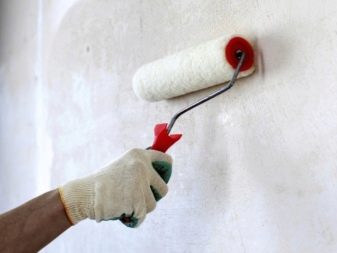
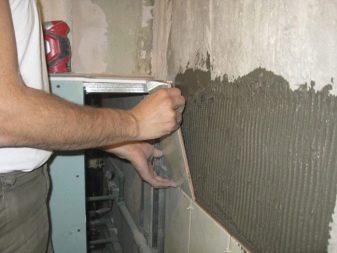
According to this principle, it is necessary to glue all the modules. If any of them lays down crookedly, it is removed and glued again. This must be done immediately, before the glue sets. Identical seams must be made between the tiles using plastic crosses. The second and subsequent rows are equal to the first.
If you have applied a little glue, it is advisable to let the first row dry. This will save the second and subsequent ones from the appearance of a slope from the wall and an increase in the thickness of the glue. When laying tile after tile, remove any excess cement immediately. After he grabs, it will be problematic to do this.
In the process of work, it is necessary to close the end. This can be done with a sealant. It is applied with a construction gun, spread in a thin and even layer, trimming with a rubber trowel for grouting. Sealant treatment is performed from all sides (side, top and bottom).
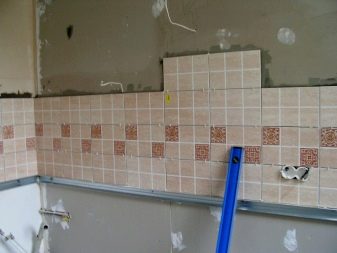

For information on how to make an apron in the kitchen from tiles, see the next video.













The comment was sent successfully.